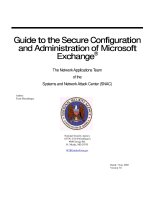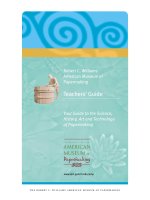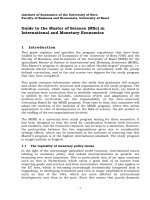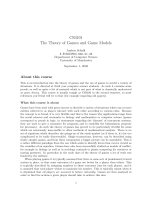Study guide to the theory of money and credit
Bạn đang xem bản rút gọn của tài liệu. Xem và tải ngay bản đầy đủ của tài liệu tại đây (883.91 KB, 264 trang )
/>
/>
/>
/>
Study Guide
THE THEORY OF
MONEY AND CREDIT
Robert P. Murphy
LvMI
MISES INSTITUTE
/>
The Theory of Money and Credit was translated from the German by
H.E. Batson and published by Jonathan Cape (London) in .
Copyright © by the Ludwig von Mises Institute
Published under the Creative Commons Attribution License ..
/>
Ludwig von Mises Institute
West Magnolia Avenue
Auburn, Alabama
:
978-1-61016-235-7
Mises.org
/>
CONTENTS
................................................................................................
Preface
. . . . . . . . . . . . . . . . . . . . . . .
ix
I. THE NATURE OF MONEY
. The Function of Money . . . . . . . . . . . . .
. On the Measurement of Value
. . . . . . . . . .
. The Various Kinds of Money . . . . . . . . . . .
. Money and the State
. . . . . . . . . . . . . .
. Money as an Economic Good . . . . . . . . . . .
. The Enemies of Money . . . . . . . . . . . . .
II. THE VALUE OF MONEY
. The Concept of the Value of Money . . . . . . . .
. The Determinants of the Objective Exchange Value,
or Purchasing Power, of Money . . . . . . . . . .
/>
Study Guide to The Theory of Money and Credit
. The Problem of the Existence of Local Differences
in the Objective Exchange Value of Money . . . . .
. The Exchange Ratio Between Money of Different
Kinds . . . . . . . . . . . . . . . . . . . . .
. The Problem of Measuring the Objective
Exchange Value of Money and Variations in It
. . .
. The Social Consequences of Variations in the
Objective Exchange Value of Money . . . . . . . .
. Monetary Policy
. . . . . . . . . . . . . . . .
. The Monetary Policy of Étatism
. . . . . . . . .
III. MONEY AND BANKING
. The Business of Banking . . . . . . . . . . . . .
. The Evolution of Fiduciary Media
. . . . . . . .
. Fiduciary Media and the Demand for Money . . . .
. The Redemption of Fiduciary Media
. Money, Credit, and Interest
. . . . . . .
. . . . . . . . . . .
. Problems of Credit Policy . . . . . . . . . . . .
IV. MONETARY RECONSTRUCTION
. The Principle of Sound Money . . . . . . . . . .
. Contemporary Currency Systems . . . . . . . . .
. The Return to Sound Money . . . . . . . . . . .
/>
Contents
APPENDICES
. On the Classification of Monetary Theories
. . . .
. Translator’s Note on the Translation of Certain
Technical Terms . . . . . . . . . . . . . . . .
Glossary . . . . . . . . . . . . . . . . . . . . . . .
Index . . . . . . . . . . . . . . . . . . . . . . . .
/>
/>
PREFACE
................................................................................................
When “Joe the Plumber”—a small business owner who became a
hero among conservatives when he challenged candidate Barack
Obama’s proposed tax hikes in the presidential campaign—
compiled a list of Christmas book recommendations for The American Spectator, he included The Theory of Money and Credit, saying it
was “important reading for these troubled times.” Although Austrians were glad that someone was bringing attention to Mises’s
classic work, many were understandably skeptical. After all, The
Theory of Money and Credit is a hard book to read.
The present study guide seeks to change that common impression. In preparing it, I have found that Mises’s work can be difficult
at times, but there is a definite method behind it. In other words,
if the reader will put in the effort to work through the book
methodically, he or she will see that Mises systematically builds
his argument from one chapter to the next. With the help of this
study guide, even the layperson will be able to unlock the amazing
insights contained in this tome, first published a century ago.
One of the most enjoyable surprises for me was to discover
just how impressive an economist Ludwig von Mises really was,
even at a relatively young age. In this single work, Mises integrated (what we now call) microeconomics with macroeconomics.
He successfully applied subjectivist, marginal utility theory to the
case of money—a task that had eluded earlier theorists in the Austrian tradition. As if that weren’t enough, Mises gave a systematic
explanation of the boom-bust cycle, blaming it on the artificial
/>
Study Guide to The Theory of Money and Credit
expansion of bank credit and the corresponding reduction of the
money rate of interest below the “natural” rate.
These accomplishments alone would have earned Mises an
important seat in the history of economic thought. Yet upon my
most recent reading, I realized that Mises showcases much more of
his talent. For one thing, he displays a thorough command of the
relevant literature, not only in pure economic theory but also in
applied topics such as money and banking. He also shows a practical understanding of actual financial markets, which often behave
differently from the depiction in academic writings. In the final
section of the book (written after the original release), Mises offers
very wise policy recommendations for returning to sound money.
The format of the study guide follows the edition of The
Theory of Money and Credit published by the Mises Institute. I follow Mises’s work very closely, down to the individual section headings. Each chapter contains an overall summary (except for very
short chapters), followed by a detailed outline. Then I include a
section on either “Notable Contributions” or “Technical Notes.”
There is also a list of new terms for each chapter (with a full list
included in the back as a glossary) and finally a list of five study
questions to ensure that the reader is grasping the essential points
of each chapter.
In order to modernize the style, hyphens have been dropped,
and in a few instances, spelling has been updated. However, no
content has been altered from the English translation as published
by the Mises Institute.
I hope that this study guide eases the understandable “intimidation factor” and allows a new generation of readers to experience
the wealth of wisdom contained in Mises’s first major work. As an
insightful plumber (and layperson) has remarked, it is important
reading for these troubled times.
Robert P. Murphy
Nashville, Tennessee
July,
/>
.
Part I9pt
THE NATURE OF MONEY
................................................................................................
/>
/>
Chapter ACCSUPPmethod=pdfstringdef,unicode,ActualText=1pdf:content BDCLetterSpace=-41ACCSUPPpdf:content EMC3pt 1
THE FUNCTION OF MONEY
................................................................................................
Summary
Money is necessary in a society based on private property and
the division of labor. The function of money is to facilitate these
trades: Money is a commonly used medium of exchange.
In a direct exchange, people accept goods in trade that they
intend to personally use, whether for consumption or production.
There is no medium of exchange involved in the transaction.
In an indirect exchange, at least one person in the transaction
accepts a good that he intends to trade away in the future for something else. The item that is accepted in the first trade is a medium
of exchange.
Even before the use of money, traders would have quickly discovered the benefits of indirect exchanges, and the use of media
of exchange to facilitate them. Some goods would have had a far
broader market than others. A trader who came to market with an
unmarketable good would place himself in a more advantageous
bargaining position if he engaged in an indirect exchange, by trading his good for something that was more marketable.
Because every trader would act in this fashion, those goods
that were initially more marketable, would see their marketability
enhanced even further. Over time, a community would gravitate
to one or a few commodities that would be acceptable to everyone in trade. This is how money emerged from an initial state of
/>
Study Guide to The Theory of Money and Credit
barter. Historically the market has often chosen gold and silver as
money.
Although other writers outline other “functions” of money—
such as a standard of deferred payments or a store of value—these
all flow from its definition: money is a commonly accepted medium
of exchange.
/>
Chapter 1: The Function of Money
................................................................................................
Chapter Outline
1. The General Economic Conditions for the Use of Money
A person living by himself on a tropical island would not need
money. Several people living in the same household would not
need money either, so long as they produced everything they
needed within the household. Even an entire community—consisting of thousands or millions of households, each of which specialized in producing different goods and services—could get by
without the use of money, assuming there were a central group or
person who acted as a “planner” and told everyone what to make,
and decided which portion of the total output each person would
get to consume.
However, in a society based on the division of labor, and where
private individuals own both consumption goods (TVs, radios,
Big Macs) and producer goods (tractors, factories, copper mines),
money is essential. In such a society, there is no one person or
group who decides how scarce resources will be deployed. Each
individual must make his or her own plans, which usually require
exchanging property for other people’s property. The function of
money is to facilitate these trades: Money is a commonly used
medium of exchange.
2. The Origin of Money
In a direct exchange, people accept goods in trade that they intend
to personally use, whether for consumption or production. For
example, suppose Alan has a muffin but he is really hungry for
fish. Bill, on the other hand, has a net (which can be used to catch
fish) that he doesn’t really want, but he thinks Alan’s muffin looks
/>
Study Guide to The Theory of Money and Credit
delicious. If Alan trades his muffin for Bill’s net, this is a direct
exchange. There is no medium of exchange involved in the transaction.
In an indirect exchange, at least one person in the transaction
accepts a good that he doesn’t intend to consume or use himself in
production. Rather, the person accepts a good because he plans on
trading it away again in the future. For example, suppose there is
a woman who has knitted a quilt, and she wants to exchange it for
a certain parakeet. Unfortunately, the man who owns the parakeet
doesn’t want a quilt, but is instead interested in obtaining a new
radio. The owner of the radio, however, hates birds, but is very
cold at night. The woman with the quilt, unfortunately, is very
hard of hearing and has no use for a radio.
In this scenario, no direct exchange is possible. However, the
woman could trade away her quilt for the radio—even though she
personally has no use for it—and then trade the radio in turn for
the parakeet. These two successive trades would make all three
people happier. In this example, the radio would be a medium of
exchange.
Logically, there must have been a time when people had goods
and traded with each other, but before money had arisen. Even
before the use of money, traders would have quickly discovered the
benefits of indirect exchanges—and the use of media of exchange
to facilitate them.
Some goods (eggs, milk, leather) would have had a far broader
market than others (telescopes, philosophy books, machinery). A
trader who came to market with an unmarketable good such as
a telescope probably wouldn’t be able to quickly find someone
who (a) had the items that the first trader hoped to acquire and
(b) wanted a telescope. In this case, the trader could improve his
bargaining position by trading away his telescope for something
more marketable, such as eggs, even if the trader had no desire to
eat the eggs.
/>
Chapter 1: The Function of Money
Because every trader would act in this fashion, those goods
that were initially more marketable, would see their marketability enhanced even further: They would be demanded not only by
people intending to use them directly, but also by people intending to use them as media of exchange. In any particular indirect
exchange, a trader would naturally prefer to sell his own wares in
exchange for the most marketable medium of exchange, because
this would place him in the most advantageous position as he continued looking for the goods he ultimately desired. Over time,
a community would gravitate to one or a few commodities that
would be acceptable to everyone in trade. A commonly accepted
medium of exchange is money.
Historically, gold and silver have been the two commodities
most frequently employed as money. They have very similar properties and are both excellent media of exchange.
3. The “Secondary” Functions of Money
Money is, by definition, a common medium of exchange, which
therefore serves to facilitate the exchange of goods and services.
In a market economy, this is a crucial “function” and we see
money’s importance by focusing on it. Although other writers outline other “functions” of money—such as a standard of deferred
payments, or a facilitator of credit transactions, or a store of value
through time—these all flow from its use as a common medium of
exchange.
/>
Study Guide to The Theory of Money and Credit
.
................................................................................................
Important Contributions
•
Mises references Carl Menger, whose 1871 Grundsätze (translated
as Principles of Economics) is the founding work of what is called
“Austrian” economics. Among his other contributions, Menger is
credited in the annals of the history of economic thought with giving the first satisfactory explanation of the origin of money. Rather
than assuming that money must have been created by an edict
issued by a powerful king or wise tribal leader, Menger showed
that step-by-step evolution from an initial state of barter to a monetary economy, where each person only seeks to improve his own
position at each step in the process.
•
Even in modern textbooks, writers will list several “functions” of
money. This can be confusing, because it makes it hard to pin down
exactly what money is and why it so important. Menger’s approach
—followed by Mises—is refreshingly clear: Money is defined as a
commonly accepted medium of exchange, and this characteristic
enables all of the other “functions” attributed to it.
/>
Chapter 1: The Function of Money
.
................................................................................................
New Terminology
Direct exchange: An exchange in which both parties intend to di-
rectly use the received good, either in consumption or production.
Indirect exchange: An exchange in which at least one party intends
to hold the received good, in order to trade it away in the
future for something else.
Division of labor: The situation in which people specialize in par-
ticular occupations, producing far more than they personally
can consume, and trade away their surplus to receive some
of the surplus created by others.
Medium of exchange: A good that is accepted in exchange, with the
intention of trading it away to acquire something else in the
future.
Money: A medium of exchange that is generally accepted in the
community. Money typically stands on one side of virtually
every exchange.
/>
Study Guide to The Theory of Money and Credit
.
................................................................................................
Study Questions
. Would a society based on total central planning in both
production and consumption need money? Why or why
not? (p. 29)
. Why doesn’t a direct exchange involve the use of a medium
of exchange? (p. 30)
. Can you think of reasons that traders eventually gravitated
toward gold and silver as money, as opposed to other items
such as cattle or aluminum?
. Did media of exchange exist before the existence of money?
(pp. 30–32)
. For the various secondary functions of money listed by
Mises, explain how each is related to money’s role as a commonly accepted medium of exchange. (pp. 34–36)
/>
Chapter ACCSUPPmethod=pdfstringdef,unicode,ActualText=2pdf:content BDCLetterSpace=-42ACCSUPPpdf:content EMC3pt 2
ON THE MEASUREMENT OF VALUE
................................................................................................
Summary
The classical economists relied on an objective theory of value, and
naturally thought that money was a measuring rod of this objective
value. Modern economics is based on a subjective theory of value,
which traces the source of value to the mind of the individual actor.
Value is the significance given to a particular good by a person.
Subjective value is bound up with the idea of exchange. Each
party to a voluntary trade gives up an item that is lower on his value
ranking (or scale of values), in exchange for an item that is higher
on his ranking. Exchanges will occur until there are no more mutually beneficial trades. Individuals’ subjective valuations give rise to
objective exchange ratios or prices.
The law of diminishing marginal utility states that the value of
the last unit of a commodity decreases as the person acquires a
greater quantity of the commodity. The various schemes to define
an objective measurement of satisfaction—a “util”—cannot get
around the fact that value scales involve a ranking (1st, 2nd, 3rd,
etc.) and not a measurement of the intensity of value. It is impossible to perform arithmetical operations on the marginal utilities of
various units in order to compute the “total utility” or total value
of the entire stock of the good. If someone says, “Diamonds are
more valuable than water,” what he means is that if forced to give
up one diamond or one gallon of water, he would choose to give up
the latter.
/>
Study Guide to The Theory of Money and Credit
Knowledge of objective money prices causes people to revise
their subjective value scales. Objective money prices provide a
“common denominator” for the market exchange values of all the
various goods and services available.
However, money prices themselves are constantly changing.
That is why Mises and Menger prefer to say that money is an index
(not a measurement) of prices, since it is less liable to confusion.
/>
Chapter 2: On the Measurement of Value
................................................................................................
Chapter Outline
1. The Immeasurability of Subjective Use-Values
The classical economists (such as Adam Smith) relied on an objective theory of value, which held that the value of a commodity
was based on an objective criterion (such as the amount of labor
required for its production). In this mindset, it was natural to view
money as a measuring rod of this objective value. Just as a thermometer shows a higher reading on a hot day than on a cold
day—reflecting the objectively warmer temperature—so too did
the classical economists think that a higher price tag indicated that
a more expensive good had a higher objective value than a cheaper
good.
However, modern economics is based on a subjective theory of
value, which traces the source of value to the mind of the individual actor. In modern economics, value doesn’t reside in physical
things per se, but instead is an attribute ascribed to physical things
by subjective preferences. Value is the significance given to a particular good by a person, who can imagine ways to use the good
to become more satisfied.
Subjective value is bound up with the idea of exchange. If a
man values a piece of iron more than a piece of bread, it means
that he would choose the former if faced with a choice between
the two. Even Robinson Crusoe, alone on his desert island, reveals
his valuations by his “exchanges” with nature. For example, he may
value satisfying his hunger more than he values satisfying his desire
to lounge on the beach, and that is why he “exchanges” his leisure
time for coconuts (by climbing trees).
With more than one person, valuation guides exchanges made
in the marketplace. Each party to a voluntary trade gives up an
/>









